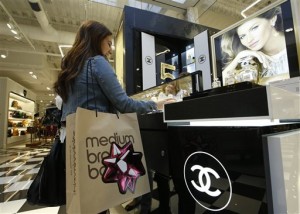
A shopper buys Chanel perfume at a Bloomingdale’s store at the Glendale Galleria shopping mall in Glendale, Calif. Americans hoping to save on European goods thanks to a falling euro shouldn’t celebrate just yet. There’s simply too much demand in the U.S. for any markdowns. (AP Photo/Damian Dovarganes, File)
NEW YORK — Americans hoping to save on European goods thanks to a falling euro shouldn’t rush to uncork that bottle of French Bordeaux. There’s very little to celebrate.
Not since September 2003 has the euro traded this low against the dollar. Still, German sports cars, Belgian beers and the latest fashions out of Italy aren’t going on sale anytime soon. The reason? There’s simply too much demand in the U.S. for any markdowns.
“The U.S. economy is the one that’s doing well in the world right now,” notes IHS senior principal economist George Magliano. “We’ve got a lot of growth in upper-income families and households.”
Since Americans are willing — and able — to spend heavily on imported goods, there’s no need for companies to cut prices. Any savings thanks to the euro’s decline will instead be pocketed by manufacturers and distributors.
It’s been a dramatic fall for the euro. Back in April, the European currency was trading at 1.38 dollars to the euro. That means that one dollar bought you about 72 euro cents.
Now the exchange rate is hovering around 1.13 dollars to the euro, so one dollar buys you 88 euro cents. The euro extended its slide against the dollar on Thursday, dropping more than 2 percent against the U.S. dollar, after the European Central Bank pledged to spend 1.1 trillion euros on bond purchases to help revive the region’s flagging economy.
The problem for Americans: we don’t buy enough European goods, except for high-end products. Our clothes might come from Bangladesh or Costa Rica. Our furniture from China. And our cars — even foreign brands like Honda — are mostly made at home.
European brands tend to cater to higher income families who want to buy a bit of prestige.
Take German cars. Brands like Audi, BMW and Mercedes are luxury products with strong demand. So there’s no incentive to cut prices, says Karl Brauer, senior industry analyst for Kelley Blue Book.
Audi sales rose 15 percent last year, while BMW sales were up 6.5 percent and Mercedes rose nearly 10 percent. Each company is likely to pocket the extra money from converting dollars to euros, no matter whether the cars are made overseas or in the U.S., Brauer says.
Volkswagen, however, might use the weak Euro to reduce prices and boost struggling sales, Brauer says. VW’s U.S. sales fell 3 percent last year even though overall U.S. auto sales across all brands grew 6 percent.
It’s the same issue with, fine wines, Gucci handbags and those designer stiletto shoes.
Bill Earle, president of the National Association of Beverage Importers, which represents 20 to 25 beer, wine and spirits importers, says the price of fancy wines like Brunello or Chianti Classico that are on the shelves now were already set three or four years ago when contracts were signed by U.S. importers. But he says if the disparity continues between the U.S. dollar and the euro, “you might see a softening of prices.”
At most, shoppers will see a two or three percent price dip, says Faith Hope Consolo, who leads retail leasing and marketing at Prudential Douglas Elliman and specializes in the luxury market.
“Anecdotally, U.S. prices haven’t gone down on European-made apparel and alcohol, though such declines would take some time to filter through the system,” Consolo says. “We probably won’t see the effects for several months.”
That’s because the production cycle for European brands takes about a year, so those so-called status products were already produced. Moreover, Nate Herman, vice president of international trade for the American Apparel & Footwear Association, noted a shift in manufacturing away from Europe and more toward Asia — like China and Vietnam — as factories in that region have improved the quality of making complicated goods.
But even if prices go down on high-end European goods, shoppers won’t feel it. Price tags have been soaring way out of reach for most Americans over the past few years. For example, Chanel’s classic handbag, which was priced at $2,250 in 2007, cost $4,900 last year, according to Robert Burke and Associates, a luxury consulting firm. And Louis Vuitton’s iconic monogram canvas handbag, which sold for $620 in 2007, climbed to $970 last year.
The one bright spot for Americans: vacations to Europe are now much cheaper. Thanks to the currency shift, travelers will pay less for hotel rooms, museum admissions and meals out.
“It’s basically a 20-percent-off sale on the whole eurozone for Americans,” says Adam Goldstein, CEO and co-founder of airfare search site Hipmunk.
There are 19 countries that use the euro. So those considering deals should look at Austria, Belgium, Cyprus, Estonia, Finland, France, Germany, Greece, Ireland, Italy, Latvia, Lithuania, Luxembourg, Malta, Netherlands, Portugal, Slovakia, Slovenia and Spain.
“This is the best time to travel to Europe in years,” says Anne Banas, executive editor of SmarterTravel. “Americans can now indulge in a fancy pastry and chocolat chaud without the budget-busting guilt.”
The catch: it will still cost a lot of money to get to Europe during peak summer months. Demand for travel is so strong that most airlines don’t have to cut prices to sell seats.